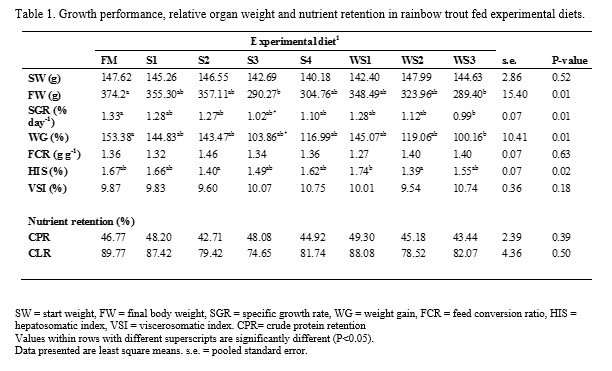EVALUATION OF GROWTH PERFORMANCE, NUTRIENT RETENTION AND APPARENT DIGESTIBILITY IN RAINBOW TROUT (ONCHORHYNCHUS MYKISS) FED GRADED LEVELS OF YEASTS SACHAROMYCES CEREVISIAE and WICKERHAMOMYCES ANOMALUS
Introduction
Plant sources, such as legumes, are still used as protein sources in commercial aquaculture diets, despite issues related to presence of anti-nutritional compounds (Gatlin et al., 2007) as well as possible lack of arable land suitable for human food production in the future (Brown, 2012). An alternative to soya beans and other legumes might be in the use of single cell protein. Langeland et al. (2014) recorded lower methionine levels in diets with baker's yeast, Saccharomyces cerevisiae, when compared to fish meal control diet and indicated a need for testing methionine supplementation in diets with baker's yeast. Yeast Wickerhamomyces anomalus, is a species commonly used in grain bio-preservation as an anti-mould agent (Olstorpe and Passoth, 2011). It is characterized by good utilization of various substrates containing a broad range of nitrogen and phosphorus sources. Aim of this study was to investigate effects of graded replacement of fishmeal by yeast S. cerevisiae and yeast mix of W. anomala and S. cerevisiae in diets for rainbow trout on growth performance, nutrient retention and nutrient digestibility as well as possible effects of crystalline methionine supplementation.
Material and methods
The reference diet (FM) contained low temperature dried fish meal as the main protein source. Test diets contained yeast S. cerevisiae (Jästbolaget AB, Sweden) that exchanged 20% (diet S1), 40% (S2) and 60 % (S3) of fish meal digestible protein. Yeast mix of Wickerhamomyces anomalus and S. cereivisae in 70:30 ratio (Jästbolaget AB, Sweden) exchanged 20% (WS1), 40% (WS2) and 60% (WS3) of fish meal digestible protein. All diets were formulated as iso-nitrogenous (digestible CP of 37%) and were supplemented with crystalline L-methionine up to total methionine content of 9 g kg-1 diet. Diet S4 contained intact S. cerevisiae, exchanging 60% of fish meal digestible protein, without methionine supplementation and was used as internal control for diet 3. Titanium dioxide (TiO2) was added to all diets as inert marker for digestibility determination and diets were produced by extrusion. Fish were kept for 70 days in triplicate groups of 35 per tank (700L volume) with an average start weight of 93.7 ± 3.8 g. Body weight and length were recorded for each fish at the start, in week 4, week 7 and the end of the experiment for calculations of growth. Surgical faeces striping was performed at the end of the experiment (ten fish per tank) for determination of the apparent digestibility of test diets. Viscerosomatic index (VSI) and hepatosomatic index (HSI) were also determined.
Results
Preliminary results showed that final body weight was not affected (P>0.05) when fish meal was exchanged up to 40% with S.cerevisiae and W.anomalus-S.cerevisiae mix. Weight gain and specific growth rate were significantly lower in fish fed WS3 when compared to reference diet. There were no differences among treatments in terms of feed conversion ratio, crude protein retention, crude lipid retention and relative weight of viscera. Apparent digestibility of crude protein was highest in fish fed FM and WS1 diets and lowest in fish fed diet S4.
Discussion and conclusion
Results of this study demonstrate that a relatively high content of both yeast protein sources of up to 40% exchange of fish meal on digestible protein basis can be used in diets for rainbow trout with no marked negative effects on final body weight. No apparent effect of methionine supplementation has been observed in growth performance as the fish fed diet S4 performed comparable to fish fed diet FM. To our knowledge, this study has achieved the highest inclusion levels of yeasts in rainbow trout diets without negative effects on growth performance.
References
Brown, L.R. (2012) Full Planet, Empty Plates: The New Geopolitics of Food Scarcity, W. W. Norton.
Gatlin, D.M., Barrows, F.T., Brown, P., Dabrowski, K., Gaylord, T.G., Hardy, R.W., Herman, E., Hu, G., Krogdahl, Å., Nelson, R., Overturf, K., Rust, M., Sealey, W., Skonberg, D., J Souza, E., Stone, D., Wilson, R. & Wurtele, E. (2007) Expanding the utilization of sustainable plant products in aquafeeds: a review. Aquaculture Research, 38, 551-579.
Langeland, M., Vidakovic, A., Vielma, J., Lindberg, J.E., Kiessling, A. & Lundh, T. (2014) Digestibility of microbial and mussel meal for Arctic charr (Salvelinus alpinus) and Eurasian perch (Perca fluviatilis). Aquaculture Nutrition, n/a-n/a.
National Research Council (2011) Nutrient Requirements of Fish and Shrimp, The National Academies Press, Washington, DC.
Olstorpe, M. & Passoth, V. (2011) Pichia anomala in grain biopreservation. Antonie van Leeuwenhoek, 99, 57-62.
